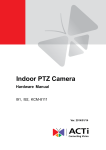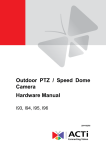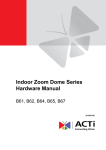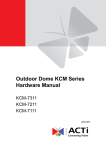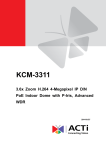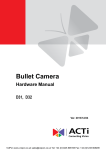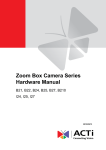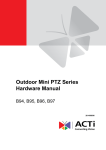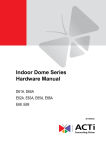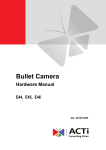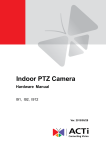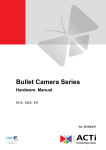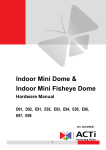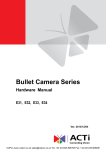Download Outdoor PTZ Camera Hardware Manual
Transcript
Encoder Firmware V4.06.09 User’s Manual Outdoor PTZ Camera Hardware Manual KCM-8211 2013/10/24 Hardware Manual Table of Contents Precautions ............................................................. 4 Safety Instructions .................................................................................... 6 Introduction ............................................................. 7 List of Models............................................................................................. 7 Package Contents...................................................................................... 8 Physical Description ................................................................................. 9 Installation ............................................................. 11 Step 1: Unpack the Camera .....................................................................11 Step 2: Mount the Camera ...................................................................... 13 Mounting Options .................................................................................. 13 Other Mounting Accessories ................................................................. 14 How to Mount the Outdoor PTZ ............................................................ 15 Step 3: Waterproof the Cable Connections ........................................... 17 How to Waterproof the Cable Using the Cable Gland ........................... 18 How to Waterproof the Cable Using the Conduit Gland ........................ 22 How to Use the Junction Box ................................................................ 26 Step 4: Connect the Equipment.............................................................. 28 How to View the Camera on Your PC ................................................... 28 Accessing the Camera ......................................... 29 Configure the IP Addresses .................................................................... 29 Access the Camera.................................................................................. 33 2 www.acti.com Hardware Manual Appendix ............................................................... 35 How to Connect Digital Input / Digital Output Devices ......................... 35 3 www.acti.com Hardware Manual Precautions Read these instructions You should read all the safety and operating instructions before using this product. Heed all warnings You must adhere to all the warnings on the product and in the instruction manual. Failure to follow the safety instructions given may directly endanger people, cause damage to the system or to other equipment. Servicing Do not attempt to service this video device yourself as opening or removing covers may expose you to dangerous voltage or other hazards. Refer all servicing to qualified service personnel. Trademarks All names used in this manual are probably registered trademarks of respective companies. Liability Every reasonable care has been taken during the writing of this manual. Please inform your local office if you find any inaccuracies or omissions. We cannot be held responsible for any typographical or technical errors and reserve the right to make changes to the product and manuals without prior notice. 4 www.acti.com Hardware Manual Federal Communications Commission Statement This equipment has been tested and found to comply with the limits for a class B digital device, pursuant to Part 15 of the FCC Rules. These limits are designed to provide reasonable protection against harmful interference in a residential installation. This equipment generates, uses, and can radiate radio frequency energy and, if not installed and used in accordance with the instructions, may cause harmful interference to radio communications. However, there is no guarantee that interference will not occur in a particular installation. If this equipment does cause harmful interference to radio or television reception, which can be determined by turning the equipment off and on, the user is encouraged to try to correct the interference by one or more of the following measures: Reorient or relocate the receiving antenna. Increase the separation between the equipment and receiver. Connect the equipment into an outlet on a circuit different from that to which the receiver is connected. Consult the dealer or an experienced radio/TV technician for help. Warning: Changes or modifications to the equipment that are not expressly approved by the responsible party for compliance could void the user’s authority to operate the equipment. European Community Compliance Statement This product has been tested and found to comply with the limits for Class B Information Technology Equipment according to European Standard EN 55022 and EN 55024. In a domestic environment, this product may cause radio interference in which cause the user may be required to take adequate measures. 5 www.acti.com Hardware Manual Safety Instructions Cleaning Disconnect this video product from the power supply before cleaning. Attachments Do not use attachments not recommended by the video product manufacturer as they may cause hazards. Do not use accessories not recommended by the manufacturer Only install this device in a dry place protected from weather. Servicing Do not attempt to service this video product yourself. Refer all servicing to qualified service personnel. Damage Requiring service Disconnect this video product from the power supply immediately and refer servicing to qualified service personnel under the following conditions: 1) When the power-supply cord or plug is damaged. 2) If liquid has been spilled or objects have fallen into the video product. 3) If the inner parts of the video product have been directly exposed to rain or water. 4) If the video product does not operate normally by following the operating instructions in this manual. Adjust only those controls that are covered by the instruction manual, as an improper adjustment of other controls may result in damage, and will often require extensive work by a qualified technician to restore the video product to its normal operation. Safety Check Upon completion of any service or repairs to this video product, ask the service technician to perform safety checks to determine if the video product is in proper operating condition. 6 www.acti.com Hardware Manual Introduction List of Models This hardware manual contains the following model: KCM-8211 2MP Outdoor PTZ Camera with D/N, Advanced WDR, SLLS, 18x Zoom lens 7 www.acti.com Hardware Manual Package Contents Check if the following items come with the camera package. If any of them is missing, please contact your local sales agents or the Customer Help Desk (CHD). Camera Power Cord Power Adaptor Cable Gland Conduit Gland Gland Rubber Rings (x2) Allen Wrench Screws Thread Seal Tape Quick Installation Guide Warranty Card 8 www.acti.com Hardware Manual Physical Description 1) Audio Output This jack connects to an audio output device, such as a speaker. 2) DC 12V Power Input This jack connects to the power adaptor and power cord to supply power to the camera. 3) Audio Input This jack connects to an audio input device, such as a microphone with built-in amplifier. Note: Make sure that the connected audio input device has a built-in amplifier. Connecting an ordinary microphone will dwarf sounds and will result in inaudible recording. 4) Ethernet Port The Ethernet port connects to a network using a standard Ethernet cable. 5) Digital Input / Output The colored cables connect to digital input or output devices, such as an alarm trigger, panic button, etc. Digital Input (DI) and Digital Output (DO) devices are used for applications like motion detection, event triggering, alarm notifications, etc. Please refer to How to Connect Digital Input / Digital Output Devices on page 35 for information on how to connect DI/DO devices to your camera. 9 www.acti.com Hardware Manual 6) Power Button The power button is used to restart the camera. In case there is a need to restart the camera, press the power button (using a pointed object, such as a pen or pin). 7) Power LED The Power LED lights red when the camera is powered up. 8) Reset Button The reset button is used to restore the factory default settings of the camera, including the administrator’s password. The reset button can be used for following purposes: 1. The administrator’s password has been forgotten and therefore the camera cannot be accessed. 2. In case of IP address, mask, or allow/deny filter related issues, resulting with inability to modify these settings. 3. In case of connectivity issues or abnormal video quality. How to do the reset properly? Step 1: Disconnect the power supply (e.g. disconnect the power adaptor or the high PoE injector). Step 2: Press and continue to hold the reset button (using a pin). Step 3: Connect the power supply while keeping the reset button pressed. Step 4: Wait for 45 seconds and release the reset button. 10 www.acti.com Hardware Manual Installation Step 1: Unpack the Camera 1. Remove the plastic cover. 2. Loosen the four screws using the bundled Allen wrench. 3. Carefully lift the camera cover and place it aside. NOTE: The cover is attached to the camera by a metallic wire; do not abruptly lift the cover. 4. Remove the outer and inner Styrofoam. Outer Styrofoam Inner Styrofoam 11 www.acti.com Hardware Manual 5. Attach the camera cover. Align the cover screws to the screw holes on the camera (as marked on the illustration) and secure the screws using the bundled Allen wrench. 12 www.acti.com Hardware Manual Step 2: Mount the Camera Mounting Options There are several mounting options that you can use to install the Outdoor PTZ camera. For more information about mounting solutions and accessories, please visit our website (http://www.acti.com/mountingselector). Mount Types Accessories Pendant Mount Suitable when mounting the Outdoor PTZ on a hard ceiling. PMAX-0102 (Straight Tube w/o Bracket) PMAX-0103 (Straight Tube with Bracket) Straight Wall Mount Suitable when mounting the Outdoor PTZ on a straight wall. PMAX-0305 (Heavy Duty Wall Mount) PMAX-0302 (Gooseneck with Bracket) PMAX-0303 (Gooseneck without Bracket) 13 www.acti.com Hardware Manual Vertical Pole Mount Suitable when mounting the Outdoor PTZ on a vertical pole. PMAX-0303 PMAX-0503 + PMAX-0305 PMAX-0503 + Horizontal Suitable when mounting the Outdoor PTZ on a horizontal pole. Pole Mount PMAX-0102 PMAX-0503 + Corner Mount Suitable when mounting the Outdoor PTZ on a corner wall. PMAX-0303 PMAX-0402 + PMAX-0305 PMAX-0402 + Other Mounting Accessories Accessories PMAX-0700 (Junction Box) PMAX-0104 (Extension Tubes) 14 www.acti.com Hardware Manual How to Mount the Outdoor PTZ Depending on the desired mounting solution, you may need to install the mounting solution first before connecting the cables or cables may be connected first before installing the mounting solutions. Below are basic installation procedures, however for more detailed information, download the Installation Guide from the website (http://www.acti.com/mountingselector). 1. Install the Mounting Solution Check the Installation Guide for detailed information. 2. Insert the Cable Insert the camera cables through the mounting tube (e.g. gooseneck, heavy wall mount, straight tube, extension tube, etc.) and through a hole in the wall or ceiling. CAUTION: The camera itself is waterproof, however take note that the cable connections are not. If the cable connections will be exposed outdoors, make sure to shield or adapt proper waterproofing methods. See Step 3: Waterproof the Cable Connections on page 17. DISCLAIMER: ACTi will not be responsible for camera damage caused by water entering the cable connections. 15 www.acti.com Hardware Manual 3. Mount the camera 1. Insert the top of the camera through the mounting tube. 2. Secure the camera with screws. 16 www.acti.com Hardware Manual Step 3: Waterproof the Cable Connections The camera itself is waterproof, however take note that the cable connections are not. If the camera is mounted directly on the wall where the cables pass through the wall, then your installation is complete and you do not need to waterproof the cable connections. However, if the camera is mounted where the cables may be exposed then it is recommended to waterproof the cable connections or use a junction box. The camera comes with a Cable Gland and Conduit Gland. It is recommended to use one of these glands when a high PoE injector will be used with the camera. However, if the bundled power adaptor will be used or digital input/output devices will be connected (see How to Connect Digital Input / Digital Output Devices on page 35), it is recommended to house the cables inside the junction box (see How to Use the Junction Box on page 26). Cable Gland Conduit Gland For use with an exterior-grade Ethernet cable For use with 1/2” flexible conduit (not (not included in the package). included in the package). See How to Waterproof the Cable Using See How to Waterproof the Cable Using the Cable Gland on page 18. the Conduit Gland on page 22. 17 www.acti.com Hardware Manual How to Waterproof the Cable Using the Cable Gland 1. Prepare the following items: Cable Gland Exterior-Grade Ethernet Cable Waterproof Tape NOTE: Not included in the camera package. NOTE: Not included in the camera package. Gland Rubber Ring Washer NOTE: The washer will not be used in this installation, please set it aside. 2. Detach the cable gland as shown below. Gland Body Clamping Nut Sealing Rubber and Claw 3. Insert the clamping nut through the Ethernet cable. 18 www.acti.com Hardware Manual 4. Insert the Ethernet cable through the sealing rubber and claw. 5. Attach one (1) supplied rubber ring on the gland body (smooth end). NOTE: Make sure the rubber ring is completely aligned on the gap on the gland body. 6. Attach the gland body to the Ethernet port of the camera. IMPORTANT! Make sure the rubber ring is completely aligned and flat on the gland body to avoid possible water leakage. For added protection, it is also recommended to apply the thread seal tape to the thread of the Ethernet port before attaching the gland body. See images below. 19 www.acti.com Hardware Manual a b c d 7. Connect the Ethernet connector to the Ethernet port of the camera. 8. Insert the sealing rubber and claw into the cable gland body. 20 www.acti.com Hardware Manual 9. Attach the clamping nut to the cable gland body. Make sure the clamping nut is tightly secured and the rubber is squeezed in to avoid water leakage. 10. Arrange all unused cables and wrap them with the waterproof tape. NOTE: Different applications and installation environments require different types of waterproofing methods which may not be covered in this manual. Check your installation environment and adapt a suitable waterproofing method. If the camera is installed outdoors and the bundled power adaptor is used, be sure to protect it from different environmental factors. It is recommended to place the power adaptor indoors or housed it inside a junction box (see How to Use the Junction Box on page 26). DISCLAIMER: ACTi will not be responsible for camera damage caused by improper use of the power adaptor. 21 www.acti.com Hardware Manual How to Waterproof the Cable Using the Conduit Gland 1. Prepare the following items: Cable Gland 1/2” Flexible Conduit Gland Rubber Ring Waterproof Tape Washer NOTE: The washer will not be used in this installation, please set it aside. NOTE: Not included in the camera package. NOTE: Not included in the camera package. 2. Detach the conduit gland as shown below. Gland Body Clamping Nut Sealing Rubber 3. Insert the Ethernet cable through the flexible conduit. Then insert the clamping nut through the flexible conduit. 22 www.acti.com Hardware Manual 4. Insert the sealing rubber and attach it at the end of the flexible conduit. 5. Attach one (1) supplied rubber ring on the gland body (smooth end). NOTE: Make sure the rubber ring is completely aligned on the gap on the gland body. 6. Attach the gland body to the Ethernet port of the camera. IMPORTANT! Make sure the rubber ring is completely aligned and flat on the gland body to avoid possible water leakage. For added protection, it is also recommended to apply the thread seal tape to the thread of the Ethernet port before attaching the gland body. See images below. 23 www.acti.com Hardware Manual a b c d 7. Connect the Ethernet connector to the Ethernet port of the camera. 8. Insert the sealing rubber into the conduit gland body. 24 www.acti.com Hardware Manual 9. Attach the clamping nut to the conduit gland body. Make sure the clamping nut is tightly secured to avoid water leakage. 10. Arrange all unused cables and wrap them with the waterproof tape. NOTE: Different applications and installation environments require different types of waterproofing methods which may not be covered in this manual. Check your installation environment and adapt a suitable waterproofing method. If the camera is installed outdoors and the bundled power adaptor is used, be sure to protect it from different environmental factors. It is recommended to place the power adaptor indoors or housed it inside a junction box (see How to Use the Junction Box on page 26). DISCLAIMER: ACTi will not be responsible for camera damage caused by improper use of the power adaptor. 25 www.acti.com Hardware Manual How to Use the Junction Box When the camera is mounted with the cable connections exposed, such as when using the corner or pole mount, use the PMAX-0700 Junction Box (not included in the package) to house the cable connections. 1. Place all the cables and the power adapter (if using one) inside the junction box. Then, secure the camera mount to the junction box. 2. From the network/power source side, insert the cables, such as the Ethernet cable, through a flex conduit with fitting (3/4”) (not included in the package) and through one of the holes of the junction box. Then connect the necessary cables. 26 www.acti.com Hardware Manual 3. Secure the flex conduit fitting onto the junction box hole. Note: The PMAX-0700 Junction Box is not a bundled accessory. Contact your sales agents to purchase. 27 www.acti.com Hardware Manual Step 4: Connect the Equipment How to View the Camera on Your PC Perform the following connections to view the camera from your PC: 1. Connect the camera and the PC to the same network using Ethernet cables. 2. Connect the camera to a power supply using the supplied power adaptor and power cord. The Power LED of the camera will flash a few times and turn off as the camera mechanical components initialize. Wait for the initialization to complete. Once complete, the Power LED will light red to indicate the camera works normally. Note: Use only the supplied power adaptor and power cord that came with the camera or the optional High PoE Injector (PPOE-0110). Using other accessories not approved by the manufacturer may cause damage to the equipment. 28 www.acti.com Hardware Manual Accessing the Camera Configure the IP Addresses In order to be able to communicate with the camera from your PC, both the camera and the PC have to be within the same network segment. In most cases, it means that they both should have very similar IP addresses, where only the last number of the IP address is different from each other. There are 2 different approaches to IP Address management in Local Area Networks – by DHCP Server or Manually. Using DHCP server to assign IP addresses If you have connected the computer and the camera into the network that has a DHCP server running, then you do not need to configure the IP addresses at all – both the camera and the PC would request a unique IP address from the DHCP server automatically. In such case, the camera will immediately be ready for the access from the PC. The user, however, might not know the IP address of the camera yet. It is necessary to know the IP address of the camera in order to access it using a Web browser. The quickest way to discover the cameras in the network is to use the simplest network search, built in the Windows system – just by pressing the “Network” icon, all the cameras of the local area network will be discovered by Windows, thanks to the UPnP function support of our cameras. In the example below, the KCM-8211 camera that has just been connected to the network is successfully found. When the left mouse is clicked on KCM-8211, the default browser of the PC is automatically launched and the IP address of the target camera is already filled in the address bar of the browser. 29 www.acti.com Hardware Manual If you work with our cameras regularly, then there is even a better way to discover the cameras in the network – by using IP Utility. The IP Utility is a light software tool that can not only discover the cameras, but also list lots of valuable information, such as IP and MAC addresses, serial numbers, firmware versions, etc, and allows quick configuration of multiple devices at the same time. The IP Utility can be downloaded for free from http://www.acti.com/IP_Utility When you launch IP Utility, the list of connected cameras in the network will be shown. See sample illustration below: You can quickly notice the KCM-8211 model in the list. Click on the IP address to automatically launch the default browser of the PC with the IP address of the target camera already filled in the address bar of the browser. 30 www.acti.com Hardware Manual Use the default IP address of the camera If there is no DHCP server in the given network, the user may have to manually assign the IP addresses to both the PC and the camera to make sure they are in the same network segment. When the camera is plugged into the network and it does not detect any DHCP services, it will automatically assign itself a default IP: 192.168.0.100 Whereas the default port number would be 80. In order to access that camera, the IP address of the PC has to be configured to match the network segment of the camera. Manually adjust the IP address of the PC In the following example, based on Windows 7, we will configure the IP address to 192.168.0.99 and set Subnet Mask to 255.255.255.0 by using the steps below: 1 3 2 4 31 www.acti.com Hardware Manual Manually adjust the IP addresses of multiple cameras If there are more than one camera to be used in the same local area network and there is no DHCP server to assign unique IP addresses to each of them, all of the cameras would then have the initial IP address of 192.168.0.100, which is not a proper situation for network devices – all the IP addresses have to be different from each other. The easiest way to assign cameras the IP addresses is by using IP Utility: With the procedure shown above, all the cameras will have unique IP addresses, starting from 192.168.0.101. In case there are 20 cameras selected, the last one of the cameras would have the IP 192.168.0.120. Later, by pressing the “Refresh” button of the IP Utility, you will be able to see the list of cameras with their new IP addresses. Please note that it is also possible to change the IP addresses manually by using the Web browser. In such case, please plug in only one camera at a time, and change its IP address by using the Web browser before plugging in the next one. This way, the Web browser will not be confused about two devices having the same IP address at the same time. 32 www.acti.com Hardware Manual Access the Camera Now that the camera and the PC both have their unique IP addresses and are under the same network segment, you can use Microsoft Internet Explorer on the PC to access the camera. Note: Only Microsoft Internet Explorer is supported by the camera at the time of writing this documentation. Please refer to our website (www.acti.com) for future upgrades. Internet Explorer supports the following functionalities: Functionality Internet Explorer Live Video Yes Live Video Area Resizable Yes PTZ Control Yes Capture the snapshot Yes Video overlay based configuration (Motion Detection regions, Privacy Mask regions) All the other configurations Yes Yes The ActiveX control for video stream management will be downloaded from the camera directly – the user has to accept the use of such control when prompted so. No other third party utilities are required to be installed in such case. Assuming that the camera’s IP address is 192.168.0.100, you can access it by opening the Web browser and typing the following address into the Web browser’s address bar: http://192.168.0.100 33 www.acti.com Hardware Manual Upon successful connection to the camera, the user interface called Web Configurator would appear together with the login page. The HTTP port number was not added behind the IP address since the default HTTP port of the camera is 80, which can be omitted from the address for convenience. Before logging in, you need to know the factory default Account and Password of the camera. Account: Admin Password: 123456 For further operations, please refer to the Firmware User Manual. 34 www.acti.com Hardware Manual Appendix How to Connect Digital Input / Digital Output Devices Depending on your surveillance needs, you may connect digital input or output devices to your camera to trigger events or notifications. Digital Input (DI) devices can be used to notify the camera about an activity in the camera site. DI can be triggers of events. For example, you can connect a “panic button” to the camera; as such when the panic button is pressed, the alarm signal will be sent through the camera. Other common DI device applications are emergency button, smoke detector, passive infrared sensor, etc. Digital Output (DO) devices are external devices that are activated by the camera upon an event inside the camera. For example, you can connect an “alarm horn” to the camera; as such when an event occurs inside the camera (e.g. detected intruder), the alarm horn will sound. Other common DO device applications are motion-triggered lights, electric fence, magnetic door locks, etc. 35 www.acti.com Hardware Manual Understanding the DI/DO Cables You can connect up to two DI and two DO devices to your camera. Device Cable Color Connection Digital Input 1 Black Ground (GND) (DI1) Red Digital Input 1 (DI1) Digital Input 2 (DI2) Yellow Ground (GND) Blue Digital Input 2 (DI2) Digital Output 1 (DO1) Brown 12V DC Orange Digital Output 1 (DO1) Digital Output 2 (DO2) Green 12V DC Purple Digital Output 2 (DO2) The table below shows the DI/DO connection specifications: Device Connection design DI DO Voltage TTL - compatible logic levels To trigger (low) Logic level 0: 0V ~ 0.4V Normal (high) Logic level 1: 3.1V ~ 30V Current 10mA ~ 100mA Connection design Transistor (Open Collector) Voltage & Current < 24V DC, < 100mA 36 www.acti.com Hardware Manual Typical Connection Based on these specifications, if the DI device has a voltage of 0V ~ 30V or the DO device has a voltage of < 24V (<100mA), then the camera can supply internal power to these devices and there is no need to connect the DI/DO device to an external power source. In this case, use the Black (GND) and the Red (DI1) cables to connect a DI device and use the Brown (12V) and the Orange (DO1) cables to connect a DO device. See wiring scheme below: Consequently, to connect a second DI or DO device, use the Yellow (GND) and Blue (DI2) cables to connect the second DI device, and the Green (12V) and Purple (DO2) cables for the second DO device. Alarm Button (DI1 Device) 12V DC Speaker (DO1 Device) Outdoor PTZ 12V DC LED (DO2 Device) Infrared Sensor (DI2 Device) 37 www.acti.com Hardware Manual High Voltage DO Device Connection Even though the camera provides 12V power, this may not be enough for some high voltage DO devices, such as a ceiling light or a motor that opens or closes a gate. In this case, there is a need to connect an external relay. See wiring scheme below: Note that when choosing an appropriate relay, please refer to its specifications and make sure they match the above design. The triggering circuit voltage has to be around 12V DC and the switch-controlled circuit voltage has to match the external power supply (e.g. 110V AC or 220V AC). The illustration below is a graphic example of connecting a relay to a high voltage DO device. 110V-220V AC External Power Source Relay (DO1 Device) ) Outdoor PTZ Illuminator Note: For more information on DI/DO connections, please refer to the article All about Digital Input and Digital Output (http://www.acti.com/kb/detail.asp?KB_ID=KB20091230001) in the Knowledge Base section of our website (www.acti.com). 38 www.acti.com







































